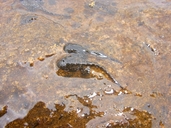|
Nannophrys marmorata Kirtisinghe, 1946
Kirthisinghe's Rock Frog | family: Dicroglossidae subfamily: Dicroglossinae genus: Nannophrys |
| Species Description: Kirtisinghe P. 1946. The genus Nannophrys Günther (Amphibia, Ranidae) with the description of the new species. Ceylon Journal of Science (B), 23(2):105-108. | |
 © 2012 Sanoj Wijayasekara (1 of 8) |
|
|
|
Description Skin of dorsum with scattered fine white tipped tubercles. Skin smooth postcranially, fairly warty, pustular on sides of body only; ventral surfaces of limbs and body smooth, no sign of pectoral white-tipped tubercles in males in the study sample. Skin coossified on to the skull (sensu Trueb 1973) in four adults examined; less evident in the nasal and frontoparietal region than in N. ceylonensis, which has thinner skin and a more heavily exostosed skull in these areas. Head depressed, broader than long. Snout smoothly rounded in dorsal and lateral views, not truncate. Nostrils nearer to the tip of snout than to the eyes, nasal prominences not elevated. No longitudinal internasal groove; nasal capsules not elevated. Canthus rostralis smooth, rounded and rather indistinct, sloping steeply to a flared upper lip. Interorbital space approximately equal to, or slightly greater than the width of an upper eyelid. A weak transverse occipital fold marks the posterior limit of the interorbital co-ossification. Tympanum distinct, moderately large and sub-oval, inclined anteriorly. Fingers in ascending order of length I : I1 : IV : 111. The distances between the tips of the first and second, and the second and third fingers are approximately equal. Tips of fingers and toes bluntly rounded; condition in juveniles not known. Inner metatarsal tubercle rather indistinct, elongate, not compressed; outer metatarsal tubercle absent. Subarticular tubercles on toes moderately elongate, less elevated in lateral view than in N. ceylonensis; medial and distal subarticular tubercles on fourth toe not in contact, distinctly separated. (The subarticular tubercles are not in contact on the other toes, or are barely in contact on third toe.) Outer metatarsals bound together. Toes free of web, or with a trace of web between first and second toes only, leaving 1+-2 phalanges free on first toe. When the hindlimbs are folded with the tibiae spread laterally and perpendicular to the long axis of the body, the heels are in contact or slightly separated (Clarke 1983). Distribution and Habitat Country distribution from AmphibiaWeb's database: Sri Lanka
Life History, Abundance, Activity, and Special Behaviors Comments
References
Batuwita S, Udugampala S, DeSilva M, Diao J and Edirisinghe U. (2019). "A review of amphibian fauna of Sri Lanka: distribution, recent taxonomic changes and conservation." Journal of Animal Diversity, 1(2), 44-82. [link] Clarke, B. T. (1983). ''A morphological re-examination of the frog genus Nannophrys (Anura: Ranidae) with comments on its biology, distribution and relationships.'' Zoological Journal of the Linnean Society, 79, 377-398. Fernando, S, L.j., Wickramasingha, M., Rodirigo, R. (2007). ''A New Species of Endemic Frog Belonging to Genus Nannophrys Günther, 1869 (Anura: Dicroglossinae) from Sri Lanka.'' Zootaxa, 1403, 55-68. Kirtisinghe P. (1946). "The genus Nannophrys Günther (Amphibia, Ranidae) with the description of the new species." Ceylon Journal of Science (B), 23(2), 105-108. Ukuwela K.U.B., Bandara I.N., De Zoysa, H.K.S., Rupasinghe, U.A.L.D., and Vandercone, R.P.G. (2020). "New Localities, Distribution and Habitat Modeling of the Critically Endangered Sri Lankan Frog Nannophrys marmorata. ." Russian Journal of Herpetology., 27, 33-40. [link] Originally submitted by: Dayupathi Eranda Nipunika Mandawala (2021-05-21) Description by: Dayupathi Eranda Nipunika Mandawala (updated 2021-05-21)
Distribution by: Dayupathi Eranda Nipunika Mandawala (updated 2021-05-21)
Life history by: Dayupathi Eranda Nipunika Mandawala (updated 2021-05-21)
Comments by: Dayupathi Eranda Nipunika Mandawala (updated 2021-05-21)
Edited by: Michelle S. Koo (2021-05-21) Species Account Citation: AmphibiaWeb 2021 Nannophrys marmorata: Kirthisinghe's Rock Frog <https://amphibiaweb.org/species/4827> University of California, Berkeley, CA, USA. Accessed Jun 7, 2025.
Feedback or comments about this page.
Citation: AmphibiaWeb. 2025. <https://amphibiaweb.org> University of California, Berkeley, CA, USA. Accessed 7 Jun 2025. AmphibiaWeb's policy on data use. |



 Map of Life
Map of Life